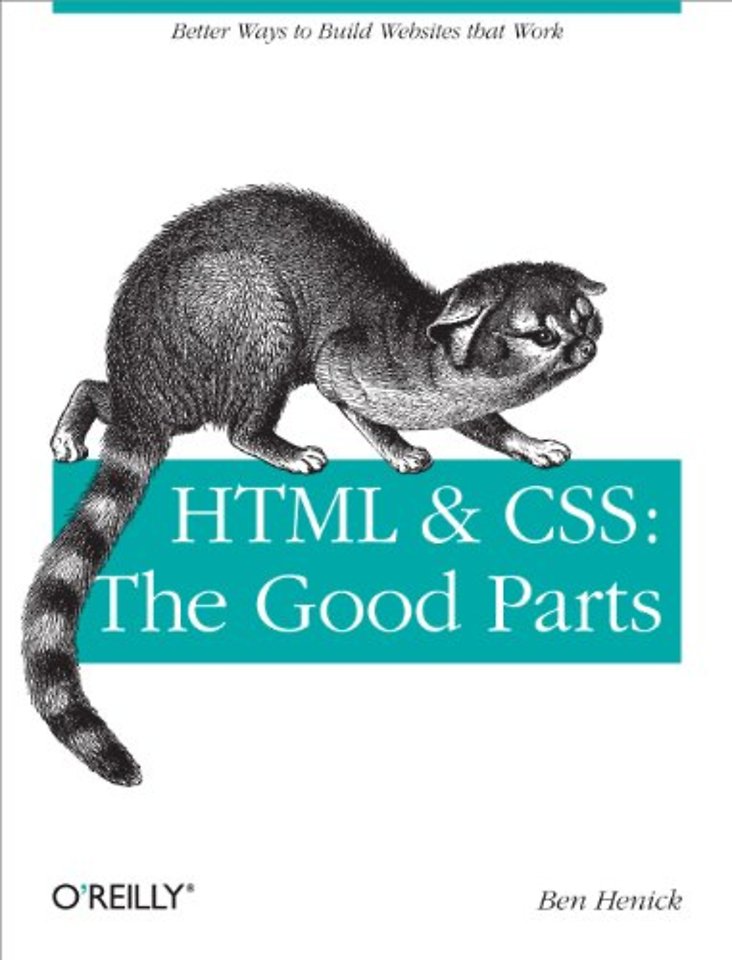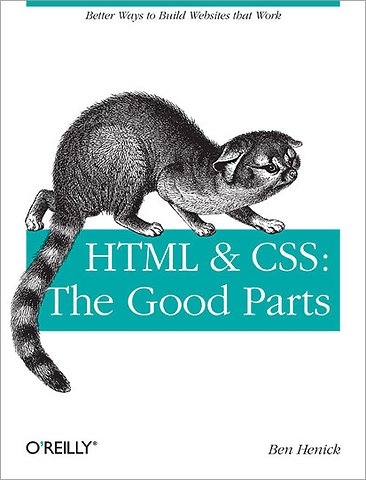


Ben Henick has been building Web sites since September 1995, when he took on his first Web project as an academic volunteer.
Meer over Ben HenickHTML & CSS The Good Parts
Better Ways to Build Websites That Work
Samenvatting
HTML and CSS are the workhorses of web design, and using them together to build consistent, reliable web pages requires both skill and knowledge. The task is more difficult if you're relying on outdated, confusing, and unnecessary HTML hacks and workarounds. Author Ben Henick shows you how to avoid those traps by going beyond the standard tips, tricks, and techniques to connect the underlying theory and design of HTML and CSS to your everyday work habits.
With this practical book, you'll learn how to work with these tools far more effectively than is standard practice for most web developers. Whether you handcraft individual pages or build templates, 'HTML & CSS: The Good Parts' will help you get the most out of these tools in all aspects of web page design-from layout to typography and to color.
- Structure HTML markup to maximize the power of CSS
- Implement complex multi-column layouts from scratch
- Improve site production values with advanced CSS techniques
- Support formal usability and accessibility requirements with tools built into HTML and CSS
- Avoid the most annoying browser and platform limitations
Specificaties
Inhoudsopgave
1. Hypertext at the Core
-The Web Without Links
-URIs
2. Working with HTML Markup
-HTML Syntax
-Rendering Modes, Flavors of HTML, and Document Type Declarations
-Beautiful Parts: Universal Attributes
-Separating Content, Structure, Presentation, and Behavior
-Browsers, Parsing, and Rendering
3. CSS Overview
-Connecting Stylesheets to HTML Documents
-Choosing the Elements You Want to Style: Writing Selectors
-Rule Conflicts, Priority, and Precedence
-CSS Property and Value Survey
-CSS Units
-Key CSS Layout Properties
4. Developing a Healthy Relationship with Standards
-The Broad Landscape of Web-Related Standards
-Why Web Standards?
-Taking the Middle Road: Standards-Friendliness
5. Effective Style and Structure
-The Four Habits of Effective Stylists
-CSS Zen and the Stylist's Experience
-Information Architecture and Web Usability
6. Solving the Puzzle of CSS Layout
-The CSS Box Model and Element Size Control
-Quirks Mode and Strict Mode
-auto Values
-Margins, Borders, and Padding
-Element Flow
-Using the display Property to Change an Element's Flow
-The float and clear Properties
-Implementing Multicolumn Layouts
-CSS Positioning Properties
-The visibility and z-index Properties
-Obtaining Precise Navigation Source Order and Layout
-Layout Types and Canvas Grids
7. Working with Lists
-Ordered and Unordered Lists
-Other Uses for Lists
-Styling Navigation Elements
-Definition Lists
8. Headings, Hyperlinks, Inline Elements, and Quotations
-Headings and Good Writing
-Styling Heading Elements
-Link Markup
-Styling Links
-Adding Semantic Value with Inline Elements
-Quotations
9. Colors and Backgrounds
-Color Theory and Web Color Practice
-CSS Backgrounds
-Composing Background Images
-Bitmapped Copy and Fahrner Image Replacement
-Reducing Server Load with Sprites
10. (Data) Tables
-The Disadvantages of Layout Tables
-The Parts of a Data Table
-Composing Cells
-Table Headers, Footers, and Heading Cells
11. Images and Multimedia
-Replaced Elements
-Preparing Images for Production
-Image Production
-Working with Color Profiles
-Image Optimization
-Publishing Images
-Styling Images and Plug-in Content
-Adding Motion and Sound: Using SWFObject to Insert Flash Videos and -Presentations
-Inserting Unwrapped Multimedia
12. Web Typography
-A Brief History of Letterforms
-A Visual Glossary of Typography
-Aliasing and Anti-Aliasing
-Type Styles, Readability, and Legibility
-Sizing Type
-Working with Typefaces and Fonts
-Character Encoding in Brief
-Creating Balanced Type Treatments
-Typographical Miscellany in CSS
-The Practice of Good Web Typography
13. Clean and Accessible Forms
-Building Effective Forms
-Assessment and Structure
-Basic Form Structure, Presentation, and Behavior
-Prototyping and Layout
-Required Fields and Other Submission Constraints
-Creating Accessible Forms
-Form Features in HTML5
14. The Bad Parts
-The Numbing Nature of Internet Explorer (Especially IE 6)
-Systemic Ugliness
-HTML's Bad Neighborhoods and Cul-de-Sacs
-CSS Travesties
-The Awful Parts
-Picking Up the Pieces
Appendix: URIs, Client-Server Architecture, and HTTP
Glossary
Index
Anderen die dit boek kochten, kochten ook
Net verschenen
Rubrieken
- aanbestedingsrecht
- aansprakelijkheids- en verzekeringsrecht
- accountancy
- algemeen juridisch
- arbeidsrecht
- bank- en effectenrecht
- bestuursrecht
- bouwrecht
- burgerlijk recht en procesrecht
- europees-internationaal recht
- fiscaal recht
- gezondheidsrecht
- insolventierecht
- intellectuele eigendom en ict-recht
- management
- mens en maatschappij
- milieu- en omgevingsrecht
- notarieel recht
- ondernemingsrecht
- pensioenrecht
- personen- en familierecht
- sociale zekerheidsrecht
- staatsrecht
- strafrecht en criminologie
- vastgoed- en huurrecht
- vreemdelingenrecht





